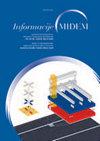用于WLAN应用的基于并发双频逆变器的低噪声放大器
IF 0.8
4区 工程技术
Q4 ENGINEERING, ELECTRICAL & ELECTRONIC
Informacije Midem-Journal of Microelectronics Electronic Components and Materials
Pub Date : 2021-01-27
DOI:10.33180/INFMIDEM2020.404
引用次数: 1
摘要
低噪声放大器;并发的;双频;本文提出了一种工作频率为2.4/5.2 ghz的两级并发双频低噪声放大器(DB-LNA),用于无线局域网(WLAN)。在基于逆变器的LNA中,采用电阻并联反馈的电流复用结构来降低功耗并实现从DC到5.5 ghz的宽频带。第二个基于逆变器的级用于增加增益并在频带上获得平坦增益。在电路输出端还插入LC网络以形成双频频率响应。该并行DB-LNA采用RF-TSMC 0.18µm CMOS技术设计,功耗为10.8 mW,电源电压为1.5 V。仿真结果表明,在2.4/5.2 ghz频段,dB - lna的直接功率增益(s21)为13.7/14.1 dB,噪声系数(NF)为4.2/4.6 dB,输入回波损耗(s11)为- 12.9/ - 14.6 dBm。本文章由计算机程序翻译,如有差异,请以英文原文为准。
Concurrent Dual-Band Inverter-Based Low Noise Amplifier (LNA) for WLAN Applications
low noise amplifier (LNA); concurrent; dual-band; inverter-basedIn this paper, a two-stage concurrent dual-band low noise amplifier (DB-LNA) operating at 2.4/5.2-GHz is presented for Wireless Local Area Network (WLAN) applications. The current-reused structure using resistive shunt-shunt feedback is employed to reduce power dissipation and achieve a wide frequency band from DC to-5.5-GHz in the inverter-based LNA. The second inverter-based stage is employed to increase the gain and obtain a flat gain over the frequency band. An LC network is also inserted at the proposed circuit output to shape the dual-band frequency response. The proposed concurrent DB-LNA is designed by RF-TSMC 0.18-µm CMOS technology, which consumes 10.8 mW from a power supply of 1.5 V. The simulation results show that the proposed DB-LNA achieves a direct power gain (S 21 ) of 13.7/14.1 dB, a noise figure (NF) of 4.2/4.6 dB, and an input return loss (S 11 ) of −12.9/−14.6 dBm at the 2.4/5.2-GHz bands.
求助全文
通过发布文献求助,成功后即可免费获取论文全文。
去求助
来源期刊
CiteScore
1.80
自引率
0.00%
发文量
10
审稿时长
>12 weeks
期刊介绍:
Informacije MIDEM publishes original research papers in the fields of microelectronics, electronic components and materials. Review papers are published upon invitation only. Scientific novelty and potential interest for a wider spectrum of readers is desired. Authors are encouraged to provide as much detail as possible for others to be able to replicate their results. Therefore, there is no page limit, provided that the text is concise and comprehensive, and any data that does not fit within a classical manuscript can be added as supplementary material.
Topics of interest include:
Microelectronics,
Semiconductor devices,
Nanotechnology,
Electronic circuits and devices,
Electronic sensors and actuators,
Microelectromechanical systems (MEMS),
Medical electronics,
Bioelectronics,
Power electronics,
Embedded system electronics,
System control electronics,
Signal processing,
Microwave and millimetre-wave techniques,
Wireless and optical communications,
Antenna technology,
Optoelectronics,
Photovoltaics,
Ceramic materials for electronic devices,
Thick and thin film materials for electronic devices.

 求助内容:
求助内容: 应助结果提醒方式:
应助结果提醒方式:


